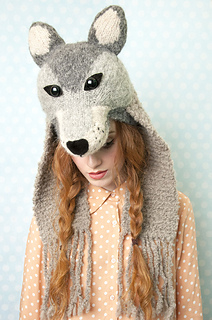 |
| Louise Walker's Wolf Headdress link: Ravelry page |
At the request of the Next Generation, I've been working on this project from Louise Walker's book, Faux Taxidermy Knits.
Assumptions
You've got the book in hand.
BLUF (Bottom Line Up Front)
The work is rated "intermediate", and I think that between the Fair Isle multi-color knitting and the final construction, that's about right.
Typos
The book contains some typos, or what I think are probably typos:
- Materials list: calls for a set of US 11 (8mm) straight needles. In the "Boucle Falls" section, the instructions call for you to knit using US 10 (7mm) needles. I did it with the US 10 needles and that's what I'd recommend.
- "Top Wolf Piece", row 56: it should be "p20b, k5b, p24a, k5b, p20b."
- "Boucle Falls": after you've obtained 6.5 inches of knitting, you're instructed to knit 22 stitches and put the remaining 23 on a stitch holder. This is the new row 1, but then you're given instructions for rows 2, 4, and 5. There is no row 3. I recommend that you simply knit all stitches for row 3.
- Then, in the next section of "Boucle Falls", it tells you to knit the other section, referencing rows 1 through 4. Then it tells you to repeat rows 4 and 5. Repeat rows 3 and 4 instead. Knit until the entire piece measures 16" (not 8" as instructed) -- in essence, so that the second fall is the same length as the first.
- "Front Ears", row 4: it should be "p7a, p4c, p7a".
Hat Base / Bottom of Snout
In the "hat base" section, round 4 tells you to "place 20 sts onto scrap yarn, k1, p1 across the remaining 6 sts." Then on the next row, you're supposed to "[knit] over the scrap yarn." This part confused me greatly. I think that it would be a lot easier if you did it like this.
First, don't place 20 stitches onto scrap yarn. Knit 20 stitches using the scrap yarn and make sure it's a contrasting color and texture. Leave a long tail and don't tie it. On the next row, k1, p1 using the original yarn all the way through. Finish the hat base pattern.
 |
| Knitting using scrap yarn |
 |
| Knitting over the scrap yarn |
Now for the "Bottom of Snout" part, what you're going to do is pick up the stitches on either side of the scrap yarn. Louise recommends using US 6 needles to do this, because it's easier, and I'd recommend it too. You'll end up with 20 stitches on either needle, and they'll be slightly offset: if you've got the top of the hat facing away from you, the top needle will have the left-hand-most stitch (look at the picture on page 46 to see what I'm talking about).
 |
| Stiches picked up |
So now you can pull out the scrap yarn and you'll have a big hole in the hat as per the picture on page 46.
 |
| The gap |
Turn the piece around so that the top of it is facing you and follow the instructions (put the right-hand-most stitch that's on what is now the bottom needle onto the top needle and then purl it and the next stitch on the top needle together). You'll end up with this:
 |
| Gap purled together |
And you can continue with the rest of the pattern as indicated.
Lessons Learned
The biggest issue for me (as a high-level beginner) besides the hat base/bottom-of-snout situation was the Fair Isle knitting. I used the yarns for which the pattern called, which were Rowen yarns - mostly an Alpaca cotton mix, but also a Boucle yarn that was British sheep wool. Side note: the Alpaca yarn is amazing. Soooooo soft. I don't usually work with high-end yarns like this. It was expensive, but worth it.At any rate, the yarn likes to cling to itself. So the primary thing I learned was that when it came time to twist the yarns behind the work, that I needed to stretch out the work flat on the working needle and make sure I twisted very loosely. The first piece I made was the hat/underjaw, and because I didn't twist loosely, the jaw ended up being puckered. I was able to smooth it out with blocking, as I did with the ear that ended up being smaller than the other ear (but be careful with that iron: I ended up burning the one ear a little).
I haven't made up the final headdress, including the stuffing, yet. I'll finish up this adventure with another blog post, provided that it turns out to be educational, which I am absolutely sure it will, because I've only ever knitted one other stuffed item (a bear) and it was terrible. Onward!

